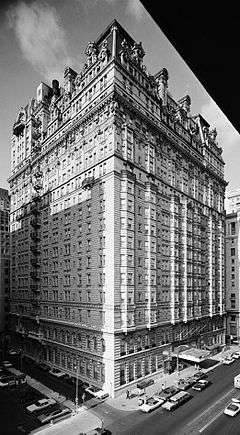1976 Philadelphia Legionnaires' disease outbreak

The 1976 Legionnaires Disease outbreak also known as Legion Fever, refers to the first known cases of infection by Legionella pneumophila in the United States.
Background
On July 21, 1976, the American Legion opened its annual three-day convention at the Bellevue-Stratford Hotel in Philadelphia, Pennsylvania. More than 2,000 Legionaires, mostly men, attended the convention. The date and city were chosen to coincide with America’s celebration of the 200th anniversary of the signing of the US Declaration of Independence at Philadelphia in 1776.[1]
On July 27, three days after the convention ended, Legionnaire Ray Brennan, a 61-year-old retired US Air Force captain and an American Legion bookkeeper, died at his home of an apparent heart attack. Brennan had returned home from the convention on the evening of July 24 complaining of feeling tired. On July 30, another Legionnaire, Frank Aveni, aged 60, also died of an apparent heart attack, as did three other Legionnaires. All of them had been convention attendees. Twenty-four hours later, on August 1, six more Legionnaires died. They ranged in age from 39 to 82, and, like Ray Brennan, Frank Aveni, and the three other Legionnaires, all had complained of tiredness, chest pains, lung congestion, and fever.[1]
Three of the Legionnaires had been patients of Ernest Campbell, a physician in Bloomsburg, Pennsylvania, who noticed that all three men had been at the Legionnaires convention in Philadelphia. He contacted the Pennsylvania Department of Health. Officials at the American Legion also began getting notices of the sudden deaths of several members, all at the same time. Within a week, more than 130 people, mostly men, had been hospitalized, and 25 had died.[1]

Epidemiology
The U.S. Centers for Disease Control and Prevention mounted an unprecedented investigation and, by September, the focus had shifted from outside causes, such as a disease carrier, to the hotel environment itself. In January 1977, the Legionella bacterium was finally identified and isolated and was found to be breeding in the cooling tower of the hotel’s air conditioning system,[2] which then spread it through the building.[3][4] This finding prompted new regulations worldwide for climate control systems.[5]
Complicating the situation was a fear among the public that the original cluster of 14 cases, six of whom died all within days of each other, represented an outbreak of swine flu. The total number of cases reached 211, and of those, 29 had died.[6] At the time of the outbreak, epidemiological investigation protocols did not include active participation by both the laboratory specialists and investigators. No effective communication existed between scientists in the field interviewing patients, and those in the laboratory testing specimens.[7][8]
Discovery of Legionella pneumophila
While the Center for Disease Control responded rapidly, as did the Pennsylvania Health Department, it wasn't until nearly a year later that Joseph McDade made the discovery that a previously identified bacterium was the cause of the outbreak. It had not been considered previously because it was believed to affect only animals. The bacterium was later named Legionella pneumophila.[9][10][11]
See also
- 1999 Bovenkarspel legionellosis outbreak
- Legionella pneumophila
- Legionellosis
- Legionnaires' disease
- List of Legionellosis outbreaks
References
- 1 2 3 Time, The Philadelphia Killer, (August 16, 1976) pages 64-65.
- ↑ "Spread by airborne droplets? Legionnaire's disease linked to water", Globe and Mail from New York Times Service, p. 10, September 4, 1978, retrieved January 18, 2014
- ↑ Ronald Kotulak (August 31, 1986), "Legionnaires` Disease Less Mysterious, Still Deadly", Chicago Tribune, p. 3, retrieved January 18, 2014
- ↑ Karina Barrymore (April 8, 1994), "Legionella Liability 'A Legal Minefield' - Legionnaires Disease: New Outbreak Expected To Hit Our Cities", Australian Financial Review, retrieved January 18, 2014
- ↑ Lawrence K Altman (August 1, 2006). "In Philadelphia 30 Years Ago, an Eruption of Illness and Fear". New York Times. Retrieved 2011-10-08.
By early August, news organizations across the country were reporting that 6 to 14 of the men in Pennsylvania had died.
- ↑ "Legionnaire disease". Encyclopaedia Britannica. Retrieved May 10, 2016.
- ↑ Hoge, C.W., and Breiman, R.F. (1991). Advances in the Epidemiology and Control of Legionella infections. Epidemiologic Reviews. 13: 329-340.
- ↑ "Legionnaires' Disease: Today and in 1976". HealthMap. 2011-10-06. Retrieved 2014-08-20.
- ↑ McDade, J.E., Brenner, D.J., Boeman, F.M.. (1979). Legionnaires' disease bacterium isolated in 1947. Ann Intern Med. 90: 659-661.
- ↑ Fraser, D.W., Tsai, T,. Orenstein, W., et al. (1977). Legionnaires' disease: description of an epidemic of pneumonia. New England Journal of Medicine. 297:1189-1197.
- ↑ McDade, JE., Shepard, C.C., Fraser, D.W., et al., (1977) Legionnaires' Disease — Isolation of a Bacterium and Demonstration of Its Role in Other Respiratory Disease. New England Journal of Medicine. 297: 1197-1203.